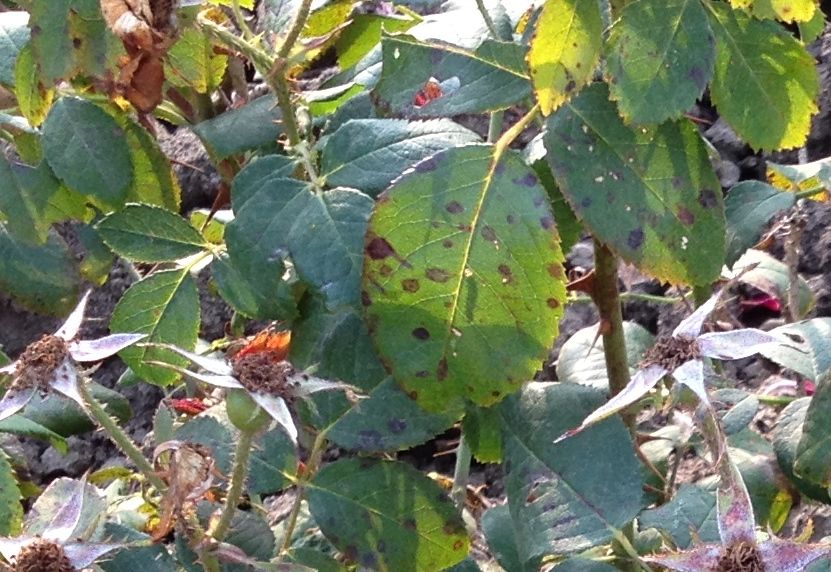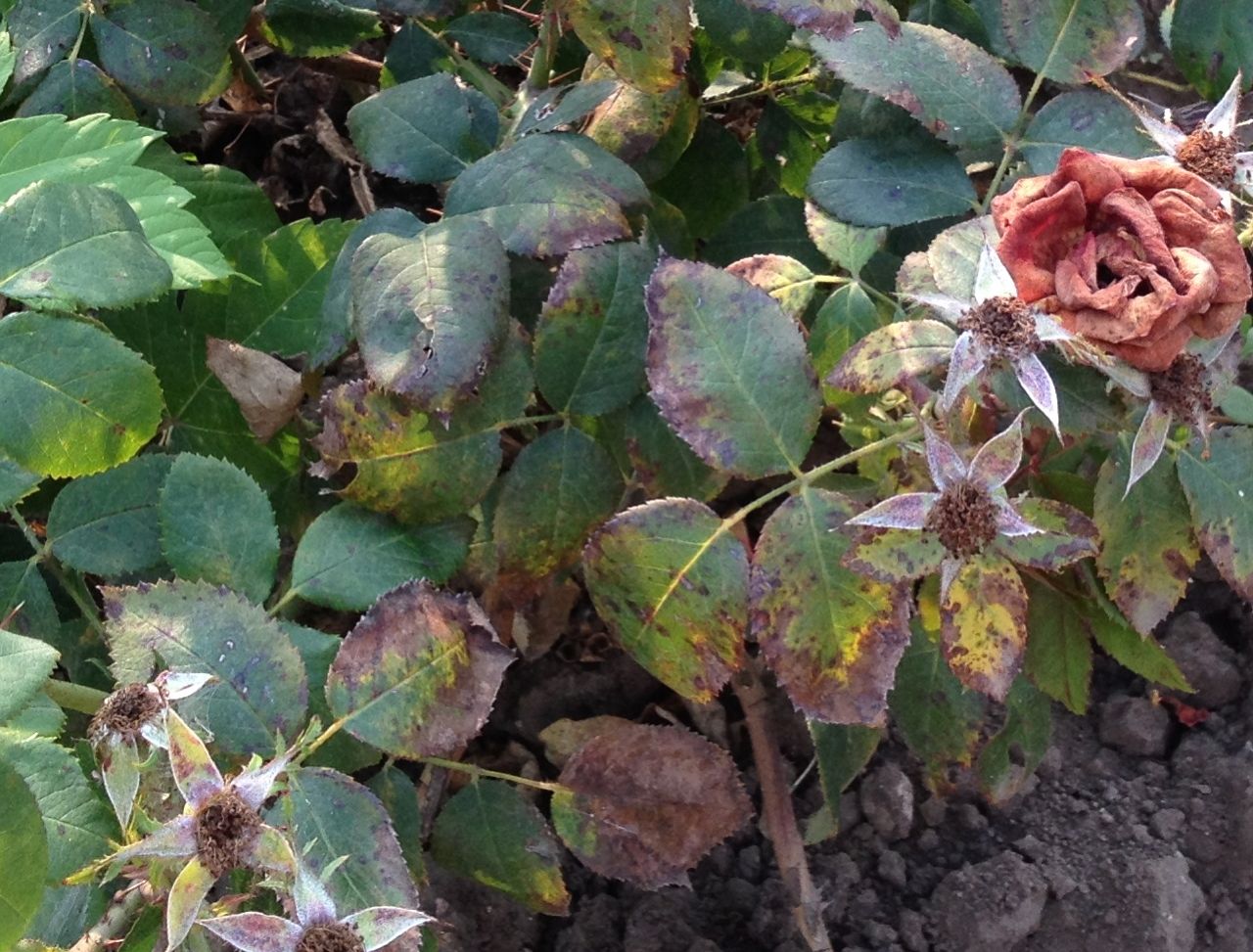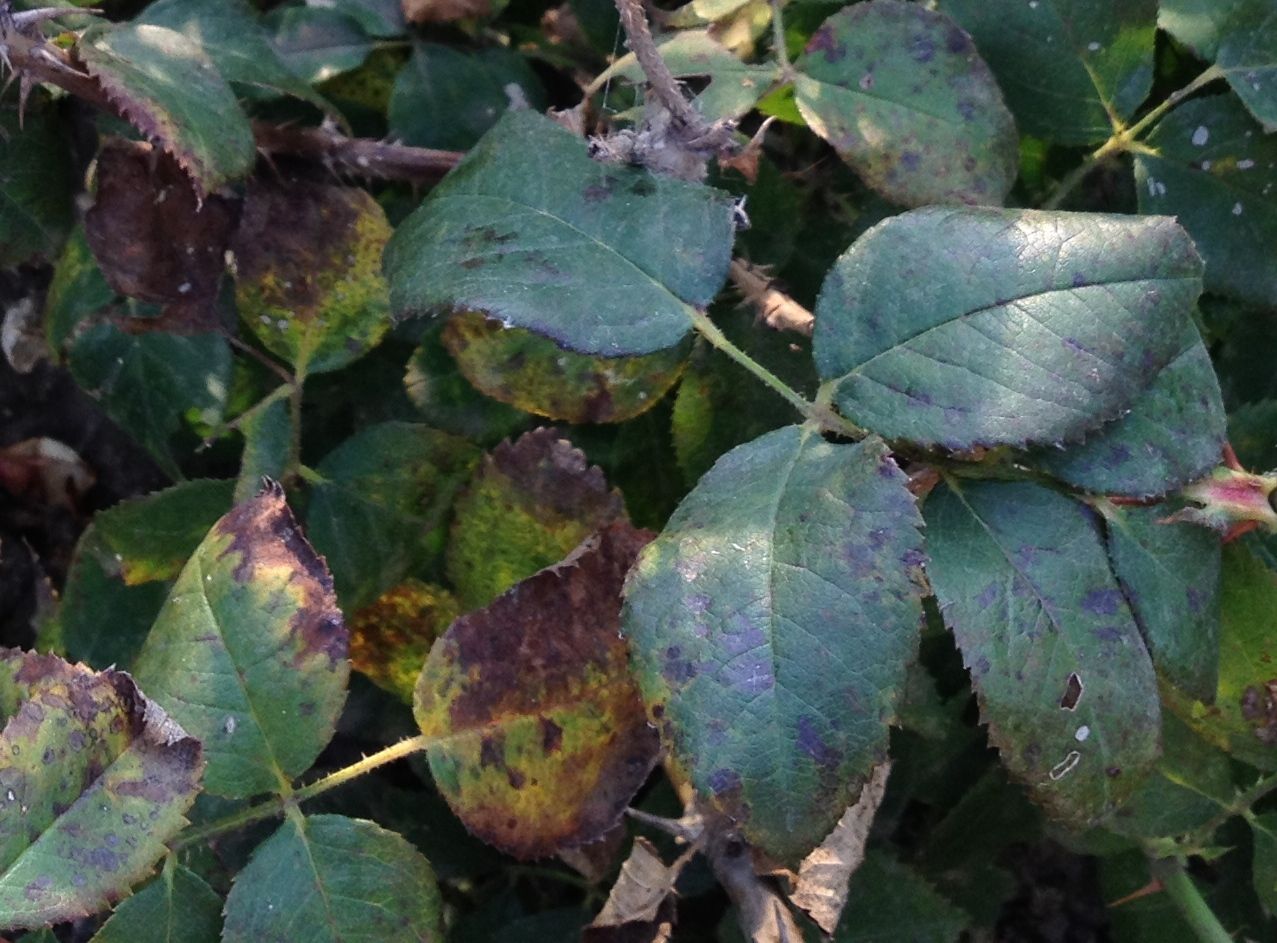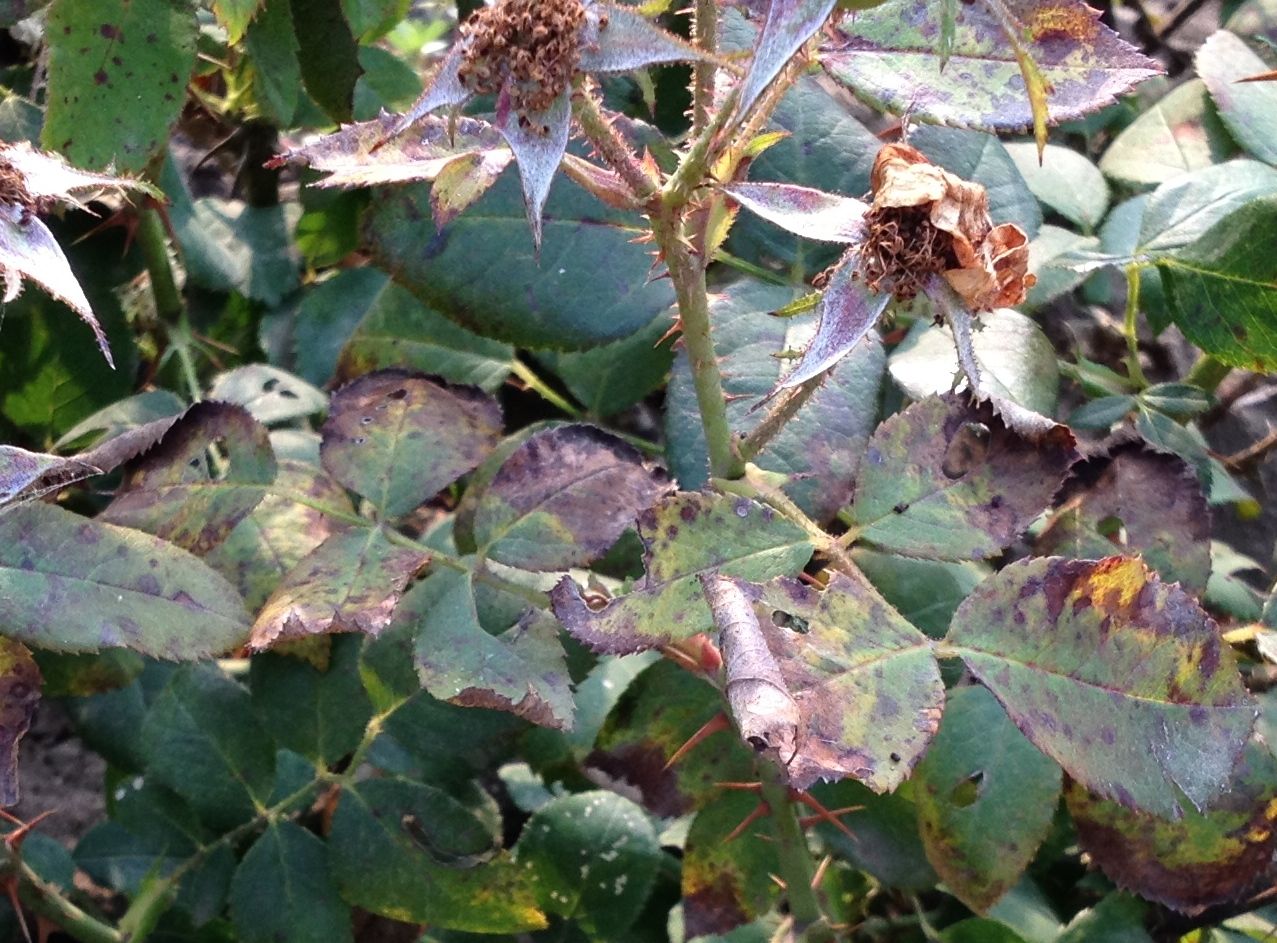I have a row of Cancan in the field that are developing some foliage issue. Could this be rust? The row continues with Brite Eyes, which are completely fine.
It doesn’t look like rust to me, Joe. Now, if it had yellow pinpoints on the upper surfaces with golden, rusty pustules on the undersides, I’d say a definite yes.
Some of the leaves in the background almost look like one of the spot diseases, though not going clear through with red haloes around like spot anthranose. But they usually drop leaflets before burning so badly at the edges. Any chance it is excess urea-containing fertilizer right before the drought?
I don’t believe we’ve fertilized them, Larry. I was blaming the drought, though. Maybe I just need to write it off as ‘leaf scorch’.
“Creeping womblegottus”.
Joe,
Could you post a few more pictures, maybe close ups of the leaves. So we get a better look at the lesions.
Per Paul’s request, here are some closeups. Click to expand.
My theory is that Cancan has excellent horizontal resistance to blackspot but poor heat or drought tolerance, and what we’re seeing is a combination of some blackspot with leaf scorching from the relatively dry conditions.




To me it doesn’t look like spot anthracnose, though there may be some lesions of it. It looks more like the black spot I see on the gallicas. Particlularly the third picture with black undefined spots and the other pictures where the edges are affected the most.
I agree with your diagnosis, Joe. To me, it looks like a combination of black spot and and foliage suffering from some drought stress. I went and looked at my lone example of CanCan today. In general, mine looks great. It is blooming again beautifully and with the exception of some very minor defoliation at the base, it remains well-foliated and the rest of the foliage is healthy. I’ve become quite attached to this plant.
Glad to hear it is doing well in Julie’s garden…the trial by fire.
Any comments about the seed fertility of Cancan, Julie? I was going to try putting pollen on it this year but I didn’t get around to it.
I have quite a few seedlings from Cancan pollen this spring, but it is too early to generalize about them.
Hi Joe,
I’ve had Can Can for four or five years now–but it was growing in a pot for part of that time as I was hoping for female fertility to use for crosses in the greenhouse. Sadly, none of the crosses I attempted resulted in a hip–if others have had better luck I would love hearing about it. I planted it outside three summers ago–I decided to throw the one plant I had in with a group of pre-trial Earth Kind selections from David that will be finishing up their evaluations in another 5 weeks. What I can say is that here (in northern Wisconsin), Can Can has far outstripped pretty much every other rose in the test group with respect to hardiness, health, and bloom power. Most are Kordes roses and while many are attractive, the vast majority of them have leafspot issues here. Also, with just a few exceptions, most struggle with being adequately hardy here–they survive but they do not thrive and remain pretty small. I have to admit that I was a bit uncertain about CanCan at first. The bi-colored blooms definitely blue with age and they might not be to everyone’s taste. The foliage is a bit different too and not the usual glossy appearance of many landscape roses. But each year the performance of this rose has become more and more impressive and there was a good two feet of live-wood this spring. Survival was actually above the snowline and, as you know, the winter was extremely cold. We’ve had a bit more rain here than you have had and are not in a drought situation (although we could use a bit now), so that may be helping it look better than at your location. Your comment about the horizontal resistance is interesting as to date, I don’t think I’ve seen any disease other that a small bit of leafspot at the base–you know how I dread that. I’d definitely recommend going another year or two with some of your plants to see if the performance improves–you didn’t say how long you’ve been observing your plants and if they are new, they may need to set their roots down a bit deeper. I’m in the same boat as you with respect to the use of CanCan’s pollen as this is the first year I became a true Can Can fan and decided to pursue further use of the plant. I have a fair number of hips resulting from crosses so the pollen fertility is quite decent–but the jury is out on what results. Also, I will be giving Can Can an additional year of trialing because the leafspot issues can take up to four years to show up–but I am cautiously optimistic. We’ll have to compare notes on seedlings next spring.
Thanks for the info, Julie!
My plants out in the field are just on their third season. They don’t get any irrigation or babying out there. I think the plants in a garden setting are doing better. My experience with the live wood was similar to yours. Cancan says, I think, Zone 6 on the tag. But they’re marketing it as a climber. As a shrub it is as hardy as any modern type.
I’m still enthused about Cancan, and your experience helps reinforce that enthusiasm. I know you’ve got the pathogens. Too bad about the poor female fertility. I have a row of them in the field and two more in a garden setting and I will see if they set any OP hips.
Brite Eyes sets tons of OP hips but out of many hundreds I got only a handful of germinations. Hopefully Cancan will have better germination, but I haven’t checked to see if there are any hips.
Last year for some reason I used a blend of Cancan and Felix LeClerc pollen. A lot of those seedlings are uber thorny and non-blooming, which I blame on Felix.
Joe,
I meant to ask you to keep me up-to-date on that black spot issue with CanCan–I’m curious to know if you are seeing much defoliation or if it is mainly lesions so far. I’ve occasionally seen black spot on Sunny Knock Out and Brite Eyes–but they seem to be able to confine the disease to a certain extent and I’ve never had much defoliation–so I hope that is the case at your place with CanCan. BTW, for the first time ever (13 years), my Prairie Joy had major defoliation from black spot in July (the first plant to show any defoliation–I was shocked) and I think the worst I’ve ever seen on it prior to this year is about 40% during my annual September disease evaluations, which makes me wonder if there might be a new race of black spot dropping into our area. The horizontal resistance to BS that Prairie Joy exhibits has usually kept defoliation to a reasonable amount and the plant has remained nice looking even with disease present–but not this year. Also, the blackspot pressure here was pretty delayed and didn’t really get going until late July. When I saw the defoliation on the plant, I had to take a second look–and I couldn’t believe that it was Prairie Joy–and it was definitely blackspot causing the defoliation.
I “think” that CanCan did/does set OP hips–and they might even be quite abundant. I seem to recall collecting some OP hips the first season I had it–but if I did, the germination was low and I know I don’t have any OP seedlings from it. Because it hadn’t yet convinced me it was a good rose, I sort of ignored it until this year when it finally came into its own and started to flourish. You are right about the hardiness–it won’t be a climber here but it will be a very reasonably hardy shrub rose with good vigor and it is probably the hardiest of the Radler roses I’ve grown. Brite Eyes does well as a shrub here but it does suffer quite a bit of die-back each winter (although with good rebound) and that had been my hardiest Radler rose to date, prior to CanCan.
Too bad about Prairie Joy…it has been one of my shining hopes. My row of PJ in the field are definitely not clean, but as you mentioned they seem to have good horizontal resistance. Their new growth is a somewhat strange coppery color right now, which I also blame on the drought.
While we’re on the topic of blackspot I will mention that some blackspot has moved in to my biggest trial garden of roses. Morden Blush and Carefree Beauty are two of the worst. I was a little surprised about Carefree Beauty. Mother of Pearl, for instance, is doing much better despite having some spots down towards the bottom.
Larry Davis, I’d take your Arctic Sunrise over Carefree Beauty any day. It is a lovely and healthy rose so far.
A.S. has better form that CB in my opinion. Nice foliage too and equally hardy here.Both get damaged at -10 so not so super up your way. In my experience A.S. makes a good fall show, much bigger blooms in the cooler weather.
Are you sure it is not a spot disease on CB? That about destroys it in PA and further east. Defoliates totally, but keeps on year after year. I have seen rare mildew on CB, more on some of its offspring, but never identifiable BS on CB.
This is the fourth season I’ve had Prairie Joy and it’s been very clean each year except 2012 where it had BS on about 40% of its leaves. Right now there are just a few leaf spot lesions on it.
I’ve had CB for nine years now and it was clean as a whistle until 2011 when I first noticed leaf spot on it. It got worse each of the next two years until last year where it was on 60% of the leaves. But this year so far to my surprise there is only a small number of lesions on it.
I had Cancan for one season and it developed severe foliage issues so it was tossed. It did develop many OP hips. My Prairie Joy shows about 10% defoliation which I can live with. Hopefully it will pass on some horizontal resistance. I’ll watch what I pair it with. Unfortunately my Carefree Beauty has completely defoliated for the second season so I ended up pulling it out and ordering Prairie Princess for delivery this week. PP seems a little more hardier than CB and hopefully more resistant.
Joe,
Did you have anything decent turn up in your Cancan F1s? I just picked up Cancan. I have some new Cancan OP seedlings from this spring but too early to make any determinations about them.
Hi Rob,
It seems like I’ve used Cancan pollen quite a bit, but I can’t think of a single seedling from it that I still have growing. Makes me go hmmm. I haven’t looked at what has actually happened in terms of germination, seed set, and seedling quality - my record keeping is a bit scattered.
Again this year I have quite a few hips ripening from Cancan pollen. My Cancan in a mulched garden area are doing fine, but it was the ones out in an unirrigated cultivated area that developed icky foliage - not really blackspot, as far as I could tell, more like rust or leaf scorch.
Still, as Julie mentioned, it is one of the hardiest Radler roses. Mine looked great this spring.
The extreme phototropic blueing of the petals is an interesting trait that might actually be detrimental to seedling quality.
I should be able to tell you more about Cancan progeny in the following years. I have some Belle Poitevine hips ripening from Cancan pollen. That could result in some very hardy rebloomers. Only time will tell.